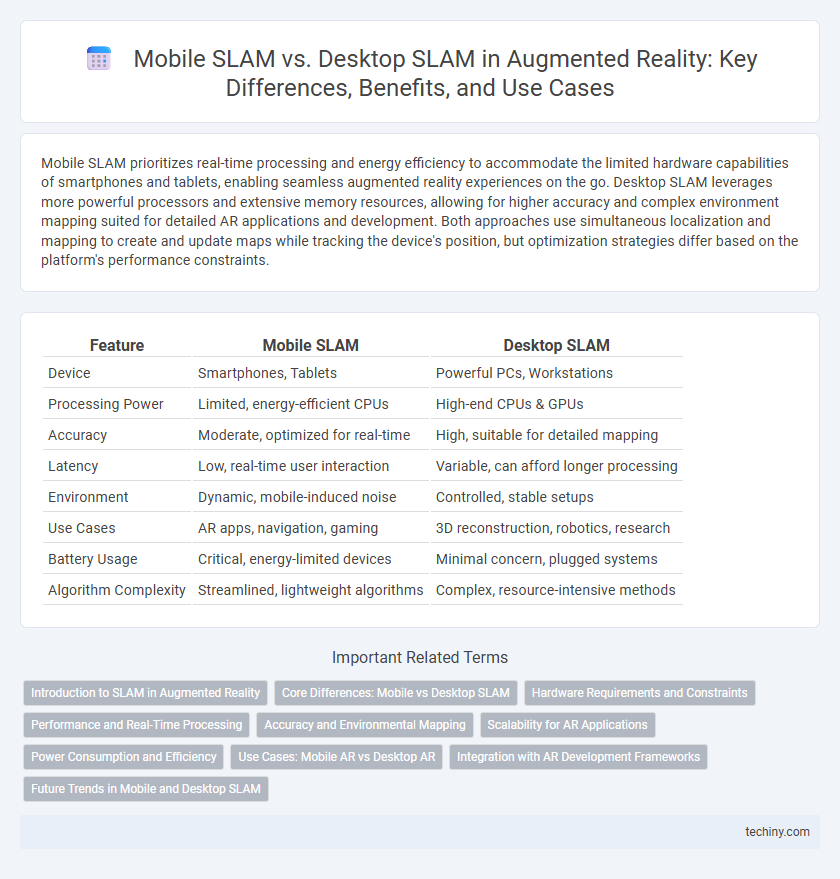Mobile SLAM prioritizes real-time processing and energy efficiency to accommodate the limited hardware capabilities of smartphones and tablets, enabling seamless augmented reality experiences on the go. Desktop SLAM leverages more powerful processors and extensive memory resources, allowing for higher accuracy and complex environment mapping suited for detailed AR applications and development. Both approaches use simultaneous localization and mapping to create and update maps while tracking the device's position, but optimization strategies differ based on the platform's performance constraints.
Table of Comparison
| Feature | Mobile SLAM | Desktop SLAM |
|---|---|---|
| Device | Smartphones, Tablets | Powerful PCs, Workstations |
| Processing Power | Limited, energy-efficient CPUs | High-end CPUs & GPUs |
| Accuracy | Moderate, optimized for real-time | High, suitable for detailed mapping |
| Latency | Low, real-time user interaction | Variable, can afford longer processing |
| Environment | Dynamic, mobile-induced noise | Controlled, stable setups |
| Use Cases | AR apps, navigation, gaming | 3D reconstruction, robotics, research |
| Battery Usage | Critical, energy-limited devices | Minimal concern, plugged systems |
| Algorithm Complexity | Streamlined, lightweight algorithms | Complex, resource-intensive methods |
Introduction to SLAM in Augmented Reality
Simultaneous Localization and Mapping (SLAM) technology is fundamental in augmented reality for creating real-time spatial awareness by mapping environments while tracking device position. Mobile SLAM optimizes processing for portable devices, balancing accuracy and computational efficiency to support AR on smartphones and tablets. Desktop SLAM leverages more powerful hardware for higher precision and complex environment mapping, enabling advanced AR applications in controlled settings.
Core Differences: Mobile vs Desktop SLAM
Mobile SLAM (Simultaneous Localization and Mapping) operates under constraints of limited computational power, battery life, and sensor quality, prioritizing real-time efficiency and energy consumption. Desktop SLAM leverages more powerful processors, advanced GPUs, and higher-quality sensors, enabling complex environment mapping with higher accuracy and dense 3D reconstruction. Core differences include processing capabilities, sensor fusion complexity, and optimization algorithms tailored to mobile hardware limitations versus desktop's capable resources.
Hardware Requirements and Constraints
Mobile SLAM systems prioritize lightweight, energy-efficient processors and low-power sensors like monocular or stereo cameras to maintain real-time localization on constrained devices, while desktop SLAM leverages high-performance CPUs, GPUs, and multi-sensor arrays for greater computational power and accuracy. Mobile platforms face strict limitations in battery life, thermal management, and memory capacity, necessitating optimized algorithms that balance precision with resource consumption. Desktop SLAM benefits from ample power and cooling, enabling advanced mapping techniques and larger-scale environment processing without significant hardware constraints.
Performance and Real-Time Processing
Mobile SLAM systems prioritize energy efficiency and sensor fusion optimization to deliver real-time 3D mapping on resource-constrained devices, often utilizing inertial measurement units (IMUs) alongside cameras for faster localization. Desktop SLAM leverages higher computational power and advanced GPUs to achieve more accurate and detailed environment reconstruction, enabling complex algorithms like dense point cloud generation in real time. The trade-off between mobile and desktop SLAM centers on balancing processing speed, latency, and map precision to meet specific augmented reality application demands.
Accuracy and Environmental Mapping
Mobile SLAM systems prioritize real-time processing and energy efficiency, often resulting in moderate accuracy and simplified environmental mapping compared to desktop SLAM. Desktop SLAM leverages higher computational power, enabling more precise localization and detailed 3D maps with improved environmental understanding. The enhanced sensor fusion and data processing capabilities of desktop SLAM contribute to superior accuracy, especially in complex or large-scale environments.
Scalability for AR Applications
Mobile SLAM systems prioritize real-time processing and energy efficiency to support scalable AR applications on resource-constrained devices, while desktop SLAM leverages higher computational power for enhanced accuracy and larger-scale environment mapping. Scalability in mobile SLAM adapts to dynamic user environments with limited hardware, optimizing sensor fusion and localization under stringent latency requirements. Desktop SLAM offers extensive scalability through advanced algorithms and hardware acceleration, enabling complex AR applications that require detailed spatial understanding and persistent tracking across expansive settings.
Power Consumption and Efficiency
Mobile SLAM prioritizes power efficiency by utilizing optimized algorithms and hardware acceleration tailored for battery-powered devices, enabling real-time tracking with minimal energy consumption. Desktop SLAM benefits from higher processing power and larger energy budgets, delivering more accurate and complex environment mapping but at a significantly increased power usage. Efficient mobile SLAM implementations balance computational demands to extend battery life while maintaining acceptable accuracy for augmented reality applications on smartphones and tablets.
Use Cases: Mobile AR vs Desktop AR
Mobile SLAM excels in use cases requiring real-time environment mapping and tracking for handheld devices, enabling immersive AR experiences in navigation, gaming, and on-the-go retail applications. Desktop SLAM is optimized for high-precision, resource-intensive AR applications such as industrial design, architectural visualization, and complex simulations that benefit from powerful hardware and larger display interfaces. The choice between Mobile SLAM and Desktop SLAM depends on the mobility requirement, computational capacity, and the complexity of the augmented reality task.
Integration with AR Development Frameworks
Mobile SLAM solutions excel in seamless integration with AR development frameworks such as ARKit and ARCore, enabling robust real-time tracking and environment mapping on smartphones and tablets. Desktop SLAM systems often provide higher computational power and precision but face challenges in direct integration with mobile-focused AR SDKs, requiring additional middleware or custom adaptations. Efficient integration in mobile SLAM enhances user experience through optimized sensor fusion and low-latency spatial understanding critical for interactive AR applications.
Future Trends in Mobile and Desktop SLAM
Future trends in Mobile SLAM emphasize increased integration of AI-driven sensor fusion and edge computing to enhance real-time mapping accuracy and reduce latency on portable devices. Desktop SLAM advancements focus on leveraging high-performance GPUs and multi-sensor arrays to achieve more detailed environmental reconstructions and support complex applications such as large-scale VR simulations. Both platforms are converging toward hybrid models that balance computational power with mobility to enable seamless, context-aware augmented reality experiences across diverse hardware ecosystems.
Mobile SLAM vs Desktop SLAM Infographic

 techiny.com
techiny.com